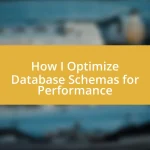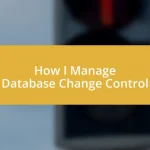Key takeaways:
- Normalization techniques, including Min-Max Scaling and Z-score normalization, are essential for making data analysis clearer and more insightful by adjusting scales and highlighting patterns.
- Applying normalization improves the performance of machine learning models and enhances data integrity, leading to more reliable results and decision-making.
- Challenges like outliers and loss of interpretability can arise during normalization, necessitating a tailored approach and thorough documentation for effective analysis.
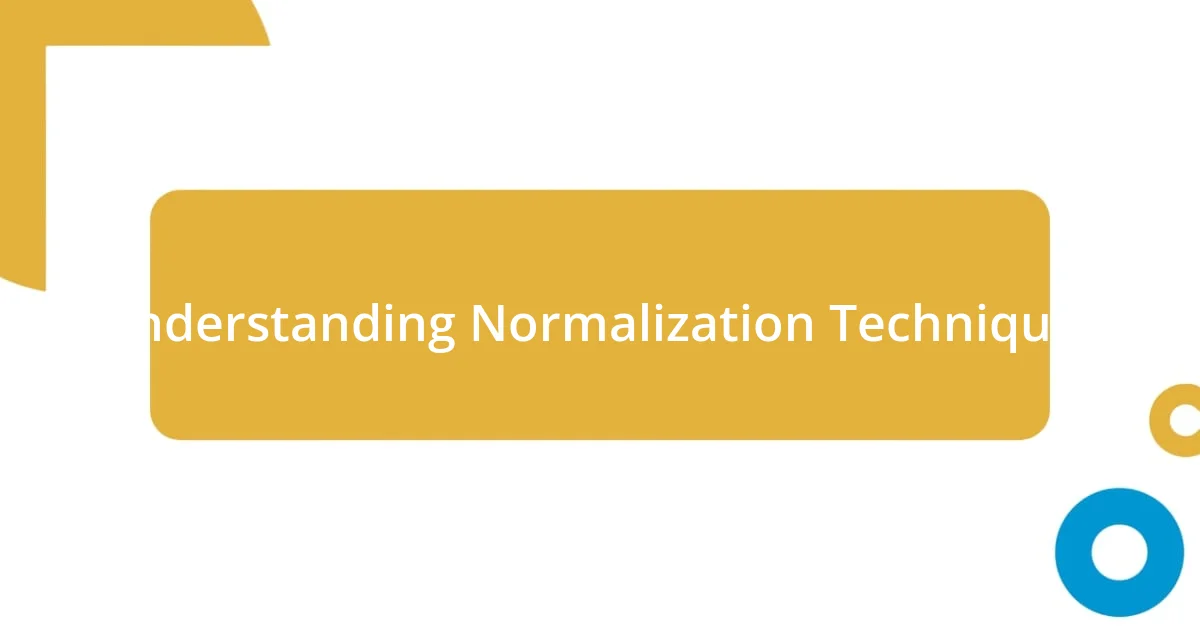
Understanding Normalization Techniques
Normalization techniques are essentially methods used to adjust the scales of data attributes, making them easier to analyze. I remember grappling with a dataset that had vastly different ranges, and it was frustrating to see skewed results due to those disparities. Have you ever tried comparing apples to oranges? That’s what it felt like until I discovered normalization techniques.
One common approach that I found effective is Min-Max Scaling, which rescales the data to a specific range, often between 0 and 1. The first time I applied this technique, it was like turning on the lights in a dimly lit room; suddenly, patterns in the data emerged that I hadn’t noticed before. It made me realize just how essential these techniques can be for gaining clearer insights and making informed decisions.
Another technique that I’ve experimented with is Z-score normalization, which involves subtracting the mean and dividing by the standard deviation. It struck me how this method emphasizes the relative position of data points, allowing for a better understanding of outliers. Have you had moments where data didn’t quite fit your expectations? This approach can help clarify those anomalies, leading to deeper insights that can turn confusion into opportunity.
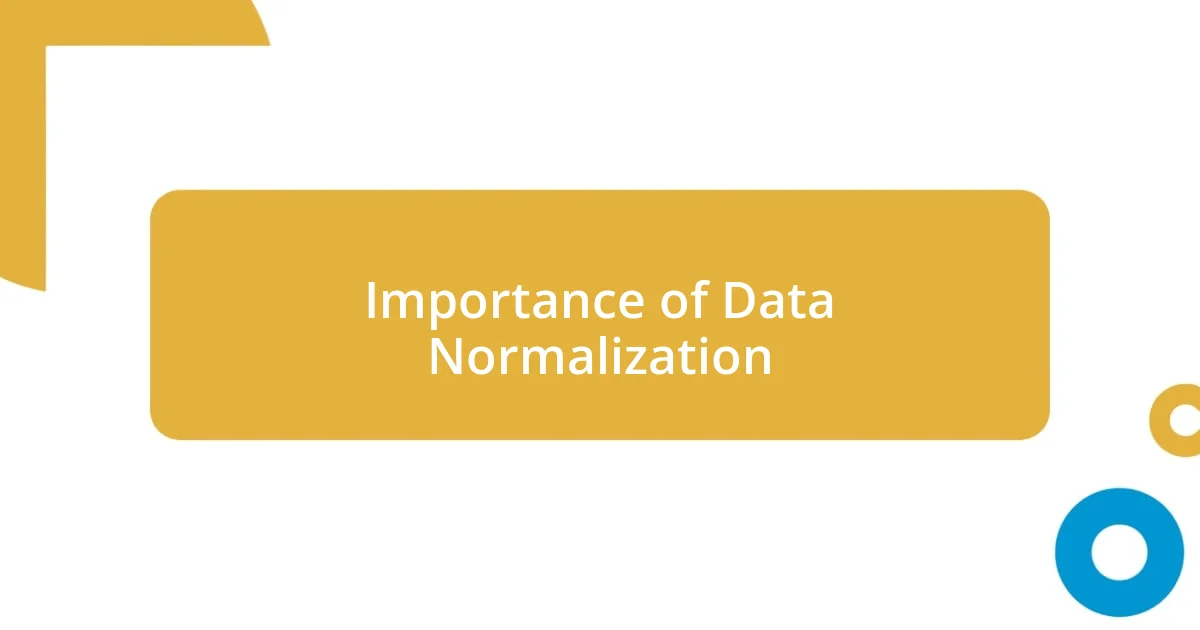
Importance of Data Normalization
Data normalization plays a crucial role in ensuring that the data remains consistent and comparable. I can’t tell you how many times I’ve encountered datasets where one variable dominated the analysis simply because it had a larger scale. It’s almost like trying to hear a whisper in a room full of shouting—normalization lets all voices be heard equally. The feeling of relief when I first saw balanced results was profound; it felt like finally piecing together a puzzle that had been frustratingly incomplete.
Beyond just comparison, normalization also helps improve the performance of machine learning algorithms. I once participated in a project where we neglected to normalize our data, leading to a model that underperformed. We were baffled at first, but after applying normalization techniques, the results skyrocketed. It was as if a shroud had been lifted, and I learned firsthand that obscuring vital data due to scale differences can be a misstep that costs both time and resources.
The importance of normalization extends to reducing redundancy and improving data integrity. Reflecting on past projects, I noticed that normalized datasets led to cleaner, more actionable insights. Have you experienced the frustration of sifting through skewed information? By consistently applying normalization techniques, I found that data became more reliable, enhancing decision-making processes across the board. It’s a small step that made a huge difference in cultivating trust in my analytics.
| Aspect | Description |
|---|---|
| Comparison | Normalizes scales for easier analysis |
| Algorithm Performance | Enhances efficiency of machine learning models |
| Data Integrity | Reduces redundancy and improves reliability |
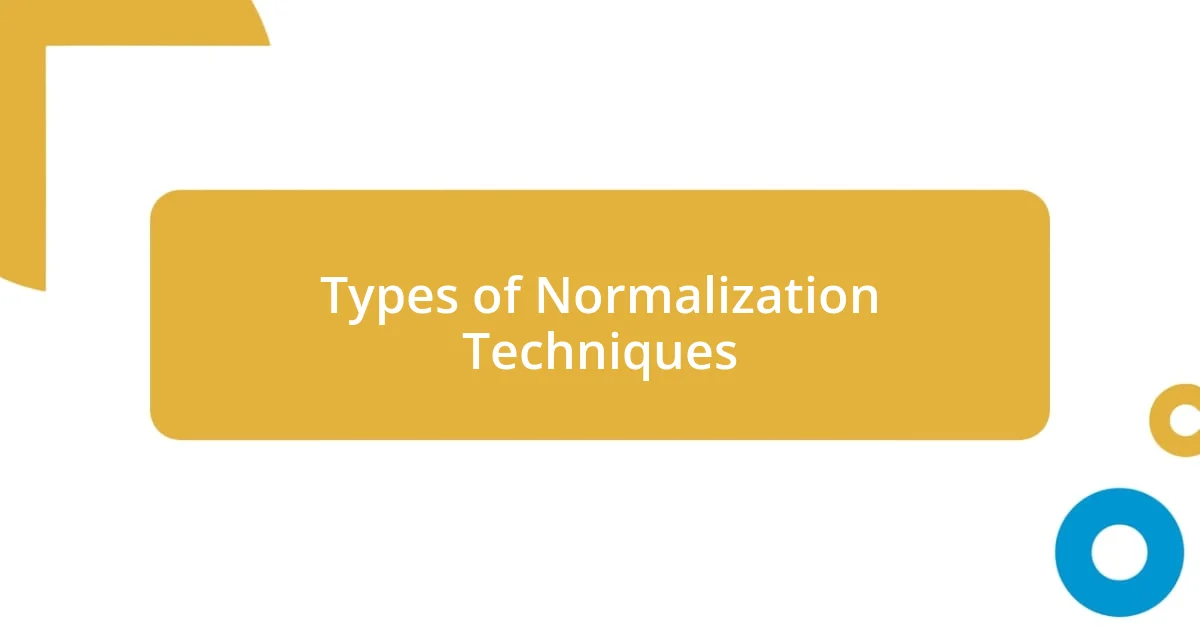
Types of Normalization Techniques
Normalization techniques can be categorized into several distinct types, each serving its purpose depending on the dataset and analysis goals. One memory that stands out is when I encountered the Log Transformation technique. I had a dataset populated with exponentially growing numbers, and using this method was like diving into a pool of calm water after a tumultuous storm; it provided clarity by compressing the range without losing meaningful patterns. I realized that while some techniques like Min-Max Scaling and Z-score normalization helped with standardization, Log Transformation uniquely tackled skewness in the data.
Here’s a quick rundown of some common normalization techniques I’ve come across:
- Min-Max Scaling: Rescales data to fit a range between 0 and 1. This is particularly useful when you want to maintain the relationships in the dataset without distorting differences in the ranges.
- Z-score Normalization: Transforms data to have a mean of 0 and a standard deviation of 1. It’s excellent for understanding how far a data point is from the mean, which is so vital for identifying outliers.
- Log Transformation: Useful for dealing with skewed data. By compressing the scale, it helps to stabilize variance and make patterns clearer.
- MaxAbs Scaling: Scales each feature by its maximum absolute value, which maintains sparsity for sparse data, making it ideal for datasets with a mix of positive and negative values.
I recall how each technique brought its own strengths and challenges to light. There was a point when I thought I could rely solely on one method, only to discover that different datasets require tailored approaches. It’s a journey—maybe a bit like fitting pieces of a puzzle together, where finding the right piece goes a long way toward revealing the complete picture.
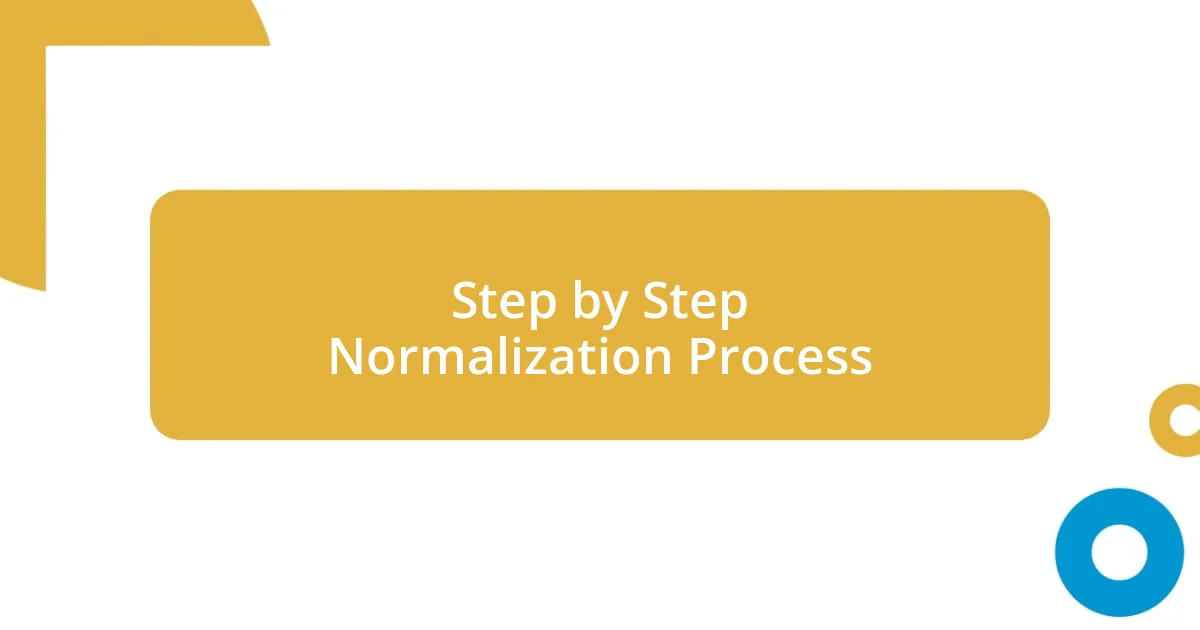
Step by Step Normalization Process
The step-by-step normalization process begins with data assessment. I once took on a project where the initial datasets were riddled with inconsistencies. It was like trying to read a book with missing pages! First, I carefully examined each variable to identify which normalization technique would fit best. This stage is crucial because understanding your data is paramount before any adjustments can be made.
Next, I implemented the chosen normalization technique. When I used Min-Max Scaling on a diverse dataset, the transformation felt rewarding. It was thrilling to see how everything aligned beautifully, bringing clarity and uniformity. Have you ever felt the satisfaction of turning chaos into order? That’s precisely what normalization achieves, making data visually and analytically approachable.
Finally, I always encourage testing the normalized data against the original to evaluate the impact of your chosen technique. This reflection moment is enlightening. In one instance, I noticed that using Z-score normalization uncovered previously hidden outliers that significantly influenced my analysis. It’s moments like these that remind me how vital the normalization process is—not just for tidiness but for unveiling the true stories within the data.
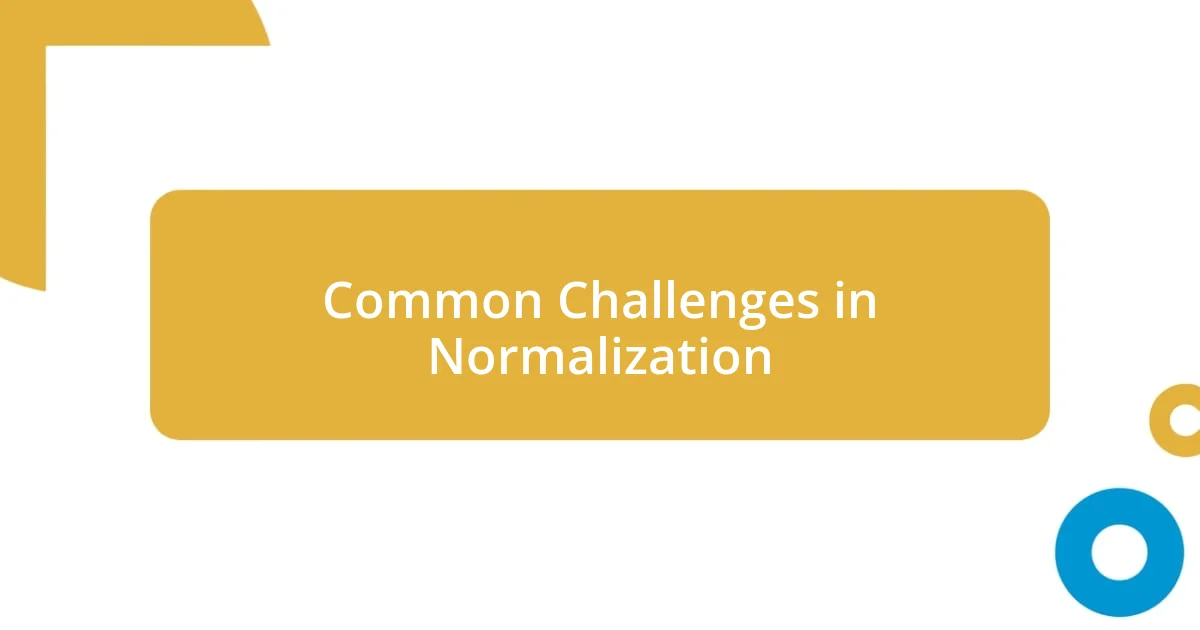
Common Challenges in Normalization
Normalization can often feel like a balancing act, where one common challenge I’ve faced is dealing with outliers. I’ll never forget a dataset I encountered that had a few extreme values skewing the results. It was as if I was trying to throw a party, but one guest was so loud and disruptive that no one else could enjoy themselves! The key takeaway here is that sometimes, removing or transforming these outliers with appropriate techniques is essential to achieve a true representation of the data.
Another challenge that frequently arises is the loss of interpretability. I remember using Z-score normalization on a project related to financial metrics. While it provided a clearer view of how each value stood relative to the mean, I found it tricky to explain the results to a non-technical audience. It’s easy to slip into jargon, and I learned the hard way that sometimes, a familiar scale like Min-Max might be better for pitching ideas. Have you found yourself wrestling with how to convey complex data insights to others? Striking that balance between technical precision and accessible communication is often an uphill battle.
Lastly, there’s the issue of selecting the right technique for the job. Each dataset holds its quirks and needs — similar to people in a room, each with unique preferences. I faced a dilemma when deciding between log transformation and MaxAbs scaling for a project, unsure which would yield the most meaningful insights. It struck me that choice is not just a mechanical decision; it’s about understanding the underlying data story. This reflection reinforced my belief that normalization is as much an art as it is a science, compelling me to embrace the uncertainty that comes with making such decisions.
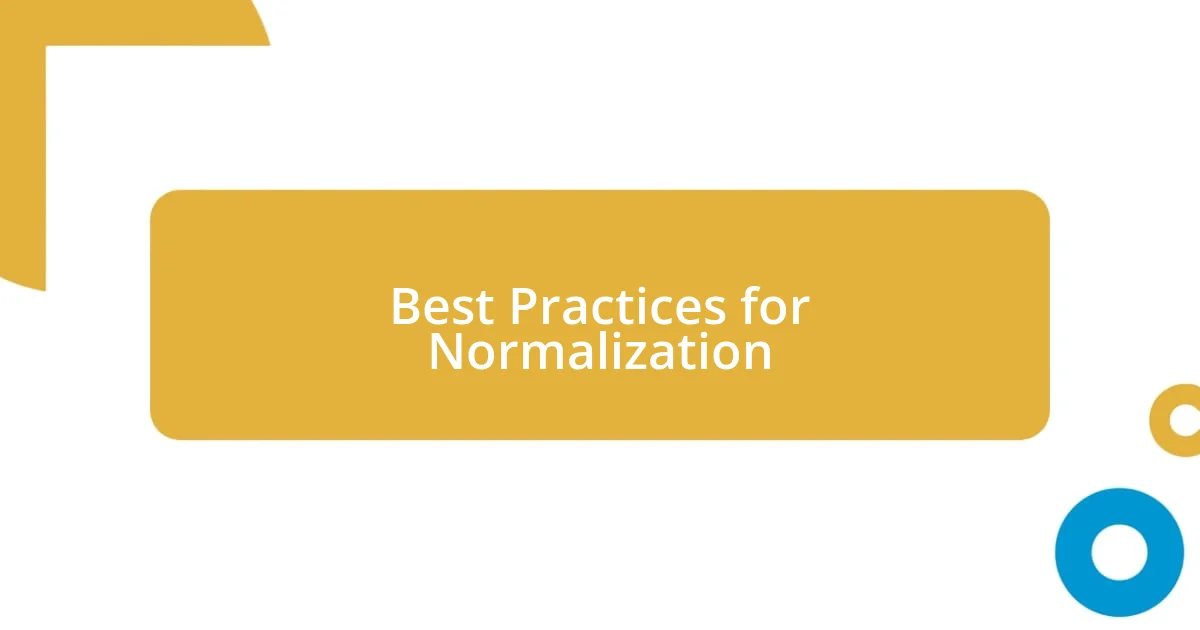
Best Practices for Normalization
When normalizing data, one of the best practices I’ve learned is to document every step meticulously. Early in my career, I skipped this and later regretted it when I had to retrace my steps for a presentation. Imagine trying to navigate a maze without a map! By keeping a thorough record, I not only saved myself from confusion but also created a valuable reference for future projects. Have you ever found yourself lost in your own data? Trust me, a simple log can be a lifesaver.
Another effective practice is to tailor your normalization approach to the specific dataset at hand. I remember a project where I defaulted to Z-score normalization, thinking it was the gold standard. However, after some trial and error, I realized that the data’s distribution was better suited for Min-Max scaling. It dawned on me that a one-size-fits-all mentality can be a pitfall in normalization. Have you had moments where a simple adjustment transformed your perspective? Adapting your methods opens the door to deeper insights and ensures meaningful analysis.
Lastly, I always emphasize the importance of visualizing the results post-normalization. After applying a logarithmic transformation on a skewed dataset, I crafted visualizations that made the findings pop. There’s something magical about seeing your hard work come to life! Have you ever experienced that same thrill? Visualization not only aids in understanding but also helps in communicating complex insights effectively. It’s like adding color to a black-and-white picture—everything becomes more vivid and engaging.
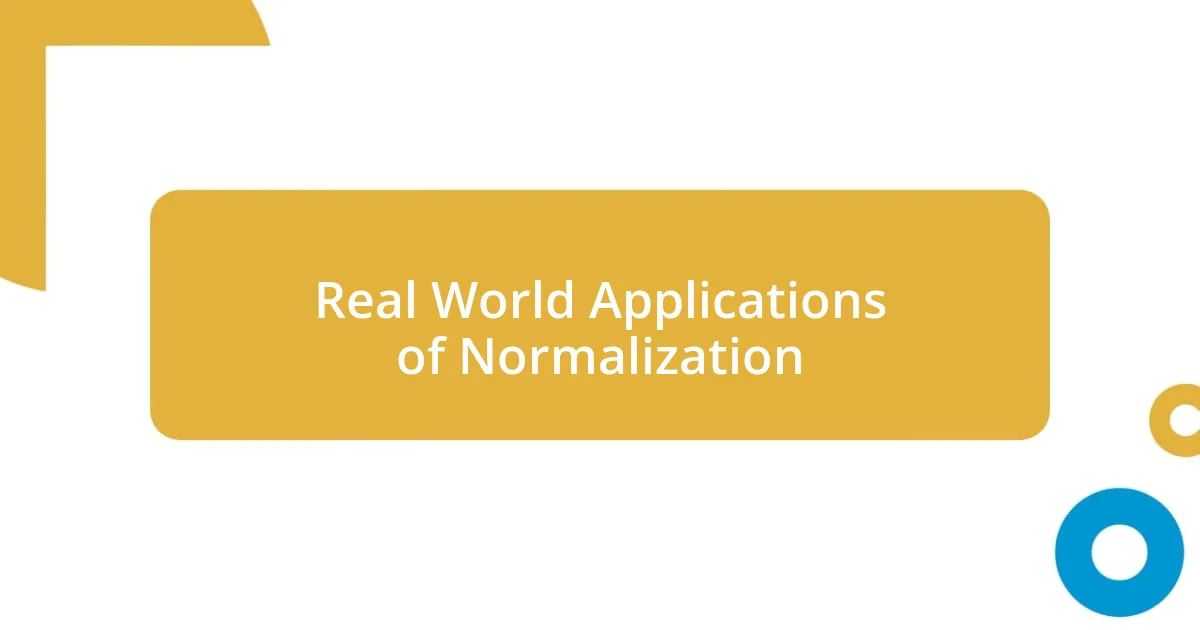
Real World Applications of Normalization
One of the most compelling real-world applications of normalization I’ve encountered is in the realm of machine learning. I remember working on a predictive model for customer churn where the features varied dramatically in scale. It was enlightening to see how applying Min-Max normalization transformed the data; it created a level playing field that allowed the model to understand the impact of each feature more effectively. Have you ever seen how minor adjustments can lead to significant improvements? It’s a reminder that normalization isn’t just a technical step; it’s a critical element in enhancing model accuracy.
Another area where I’ve found normalization extremely valuable is in visualization. I’ve worked with datasets that included variables like age, income, and spending habits, which had very different ranges. While preparing visual representations, I realized that normalizing these variables allowed for clearer comparisons. When I plotted the results, I could see relationships that were previously obscured. Doesn’t it feel great when data becomes not just numbers, but a vivid story? Normalization played a key role in painting that picture for my audience.
I also can’t overlook the role of normalization in financial reporting. In a project evaluating the profitability of different business units, I utilized z-score normalization to standardize performance metrics across varying scales. This approach clarified which units truly excelled and which were lagging, providing actionable insights for decision-makers. Have you ever thought how critical it is to have clarity in financial data? Normalization not only aided in comparison but also instilled confidence in the results presented to stakeholders. It’s fascinating how a technique can turn numbers into informed business strategies.





